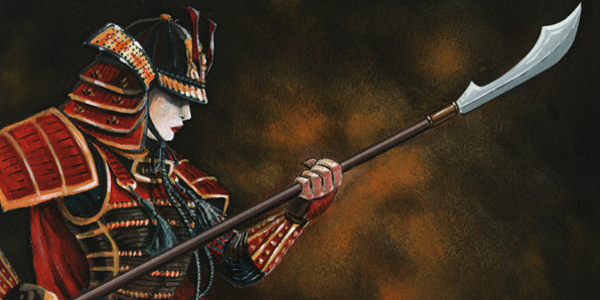Naginata is a traditional Japanese martial art of both power and grace. It is the study of the use of a sword like weapon similar to the European halberd or glaive. The original naginata weapon was a short sword mounted on a long pole or staff. It was first used on the battlefield, and then in the Edo period samurai women took it up as a method of defense and self-development.
Today, most though not all naginata practitioners are still women. In countries outside Japan there are more men studying the art. Naginata can be enjoyed by all people who are interested in either competitive fighting, or in the beauty of choreographed, practiced movements, called kata. The practice of naginata helps to foster physical and mental discipline, grace, and awareness of self and others. A further aim of the ANF is to encourage cultural exchange between Australia and Japan through visits, seminars and other shared activities.
Today’s Naginata practice weapon is made from a wooden staff with bamboo slats in place of the blade. Naginata kata (or form) is practiced with a weapon that has a wood blade fashioned similarly to metal blade. During sparring and at other times when there will be contact, armour is worn by the participants to protect the target areas. The dojo can provide armour and practice weapons for beginning and intermediate students.
A Brief Introduction to Atarashii Naginata
by Raymond Sosnowski, ECNF/USNF
Prior to the Edo period (1603 – 1867) in Japan, the Naginata was a standard pole-arm of the samurai, having the dynamics of the Bo (long staff), Tachi (saber) and Yari (spear). During the Edo period, a time of internal peace, primarily women of samurai families trained with Naginata.After the Meiji Restoration (1867), the Koryu (old styles) were taught in public schools for the physical and mental training of female students. After WWII, Atarashii or “New” Naginata was formulated based on several Koryu, and along lines similar to modern Kendo. Several Koryu, such as Tendo-Ryu and Jikishinkage-Ryu, which form the basis of “New” Naginata, are still taught today, but they emphasize Naginata vs. Tachi in Kata practice; “New” Naginata practice is exclusively Naginata vs. Naginata and include Shiai (contests). Nowadays training includes males and females in both Naginata and Kendo.
Naginata practitioners wear a white, short-sleeved Uwagi (jacket) or Keiko-gi, blue or black Hakama (samurai pants), and white Obi (belt) which is thinner and wider than a karate-style belt [in general, there is no external sign of rank]. The practice weapon is a competition-style Naginata [two bamboo staves as the Ha (blade), an oak E (shaft), and leather covers over the Kissaki (blade tip) and the Ishizuki (shaft end)],analogous to the Shinai (mock-sword) in Kendo. For Kata, advanced Yudansha (black belts), San-dan(third-degree black belt) and above, use wooden Naginata, analogous to the Bokken in Kendo, with a small leather Tsuba (guard) between the Ha and E.
Like Kendo, Atarashii Naginata practice consists of two elements: Kata (pre-arranged forms) and Jigeiko/Shiai (practice sparring/contest). In preparation for Kata practice, everyone does Happo Buri (8-direction swings) with the Naginata which acts as a solo warmup, and Uchi-kaeshi, a two-person form which is the essence of the Kihon Waza (basic techniques).”New” Naginata has two sets of two-person forms. Up through San-dan, practitioners learn and practice the 8 Shikake-Oogi with the competition-style Naginata; these Oyo Waza (applied techniques) emphasizes Kamae (posture/stance), Tai-sabaki (body movement), and Datotsu-bui (strike points) with respect Uchi-kata (offensive moves) and Uke-kata (defensive moves). For advanced Yudansha, forms practice also consists of the 7 Zen Nihon Naginata Renmei Kata with wooden Naginata; this practice emphasizes the common Budo characteristics of Ma-ai (distance), Zanshin (awareness), Kazushi (balance) and Kime (focus).
Like Jigeiko and Shiai in Kendo, practitioners in Naginata wear Bogu (practice armor). Common to both are the Men (head protector with a metal grill face protector), Do (chest protector), Tare (waist protector),and Kote (padded gloves with wrist protectors) [unlike Kendo-style Kote, these have split mitts to facilitate grip changing]; and unique to Naginata are the Sune-ate (shin protectors). Also like Kendo, contestantsare required to use the name of the intended target as a Kiai (sharp vocalization), in this case, “Men,” “Do,” “Kote,” “Sune,” and “Tsuki” (fora thrust to the throat guard). Along with correct Kiai, a strike is awarded a point if it is accurate, delivered with precise timing and proper body movement. Uchi-kaeshi and other Kihon Waza are also practicedin Bogu. Beginners who have never worked in Bogu usually have 6 to 12 months of Kata practice prior to beginning training in Bogu; practicing and former Kendo-ka may begin sooner.
Naginata, like all other Budo, has its own specific Reiho (etiquette); peculiar to Naginata are the Ritsurei (standing bow) with theNaginata, and the Zarei (seated bow) with the Naginata; there is also a set of specific Reiho for Shiai. Like Kendo, Naginata stresses “Ki Ken Tai Itchi” (the coordination of spirit, weapon and body as one); both are based on balance, coordination, and precision, not strength, and, as such,they can be practiced for a lifetime. Because of the emphasis on whole-body movement and the unique use of centrifugal force in moving the Naginata, neither age nor gender are obstacles to practice; practitioners range from school children to retirees.
Regulation of Atarashii Naginata comes from the Zen Nihon NaginataRenmei (All-Japan Naginata Federation or AJNF) via the International Naginata Federation (INF) through the United States Naginata Federation (USNF). The USNF consists of a series of regional organizations who coordinate local activities. These regional areas include the East Coast,Mid West, Rocky Mountains, Northern California, Southern California, and Hawaii. For more information on the USNF and its regional organizations, please contact Ms. Malyne Chiu, USNF Executive Secretary, 5552 Southcrest Way, San Jose, CA 95123, or E-mail to ochiu55527@aol.com.
This article was originally published in THE IAIDO NEWSLETTER, Volume 9, Number 1, Issue #77, pp. 4-5, January, 1997.


